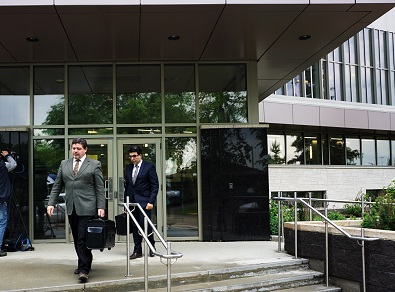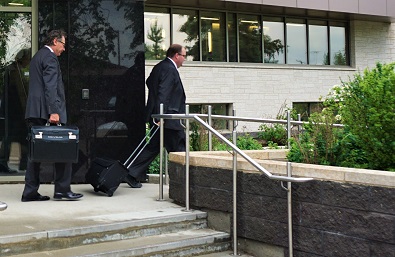Crown prosecutor Lloyd Stang leaves court on June 13, 2017. Photo by Chelsea Laskowski.
Concerns about the La Loche school shooter’s motive, sense of remorse and empathy, and continued fascination with guns have arisen at his sentencing hearing this week.
This comes after the teen shooter entered fall guilty pleas for first-degree murder of educators Marie Janvier and Adam Wood, second-degree murder of teen brothers Dayne and Drayden Fontaine, and attempted murder of seven others in the January 22, 2016 mass shooting.
The Meadow Lake court dates mark the last week of evidence and arguments before Judge McIvor is left to decide whether or not the 19-year-old, who was 17 when he opened fire in La Loche Dene Building high school and in a La Loche home, will serve an adult sentence.
On Tuesday afternoon, psychological expert Katelyn Harker appeared by video from Saskatoon, testifying both about a psychological risk assessment she prepared for court and about counselling she’s been providing for the shooter on a roughly bi-weekly basis since December. Their most recent session was early last week.
When Judge McIvor questioned Harker on patient confidentiality, Harker said she made it clear to the offender that she may be subpoenaed to comment on their talks, and said in this case that’s one of the reasons she kept her supportive counselling from addressing certain issues. In particular, Harker did not get in depth with the offender on the question most people are wondering about: “why?” She said the offender got frustrated when the specifics of the shooting were brought up and she didn’t want to push it at risk of him not allowing her to complete her report.
Outside court, Crown prosecutor Lloyd Stang commented on that topic, saying “I did not expect any magic moment in court where we would all of a sudden understand why things happened. We’re getting bits and pieces of information from a variety of sources and we may never know the exact reasons behind what occurred.”
However, in court there was mention of the offender telling his case worker that he “just wanted to see what it would be like” and got an “extreme scary rush after pulling the trigger.”
Harker said the offender told her firing a gun “puts him in a good mood,” that he enjoyed talking about guns and ammunition. She said “I was surprised he still viewed them so favourably” after the destruction he caused on January 22, 2016.
She reports the offender had been thinking about the shooting six months in advance. The fact that he only mentioned it once in passing to a friend and that sources indicate no one suspected him capable of this is particularly troubling, Harker said. She said the offender’s inclination to think such dangerous things and not share them is concerning and requires treatment.
She also mentioned concerns that forgiveness by the Fontaine victims’ families may keep him from understanding the gravity of his offences. She said it’s important for him to be held accountable, but notes she believes the offender lacks remorse for any of the events that took place at the school and has a deficit in feelings of empathy for those victims and their families. In a session just last week after hearing victim impact statements in May, Harker said the offender told her “he thought those who weren’t physically harmed were exaggerating a bit.”
He “demonstrated no emotion reliving the event” and his only mention of the school victims was of Adam Wood – not about Wood specifically, but about what it was like to shoot Wood. The offender “was surprised by the amount of damage that was done,” Harker said. Stang noted that Wood was the only one in the school shot twice.
Defence lawyer Aaron Fox leaves court on June 13, 2017. Photo by Chelsea Laskowski.
Defence lawyer Aaron Fox noted that Harker never specifically asked the offender about each of his victims, and she acknowledged that talking about big concepts can sometimes limit the offender’s ability to respond.
Overall, Harker said she feels the offender only feels remorse for killing teen brothers Dayne and Drayden Fontaine.
She provided evidence that there is no good tool for assessing risk to reoffend for violent school shooters, known as “rampage school shooters” in academic literature, because most either commit suicide or are killed by the police. This led to her recommending fresh assessments on the offender before each major move within a correctional setting or before a release, saying the offender’s risk can fluctuate depending on treatment.
“It’s difficult to measure a risk of recidivism from rampage school shooters because there are so few – in North America in particular – that are released back into the community,” Stang said outside court.
Harker said it’s possible after multiple years in a sustained environment that the offender could be considered rehabilitated, saying they need to see a sustained period of behavioral change and the time it takes to get there depends on his motivation and engagement, the treatment available, and how often a treatment team can meet with him.
Fox asked if a seven-year period is possible, and she declined to comment, saying there are not enough past cases for her to draw on.
Outside court, Stang said considering the offender’s age, “the possibility exists that at some point in the future he would get parole even if he was sentenced as an adult. If he was sentenced as a youth he certainly would be released into the community several years into the future… if he’s going to be released into the community people would be concerned about ‘what’s the risk of recidivism.’ That’s just a natural concern.”
Among other things, Harker recommended treatment for anxiety and post-traumatic stress from the loss of the Fontaine brothers.
The first week of hearings took place between May 13-16, and The Canadian Press is reporting that defence has requested and been granted a court-ordered report on the offender’s Gladue factors. These types of reports can take months, meaning final arguments from lawyers and evidence from the report writer are delayed until the report is complete.
Prosecution has now concluded its evidence, with defence evidence to be presented during the remainder of this week. The future court dates for sentencing arguments have yet to be decided.

